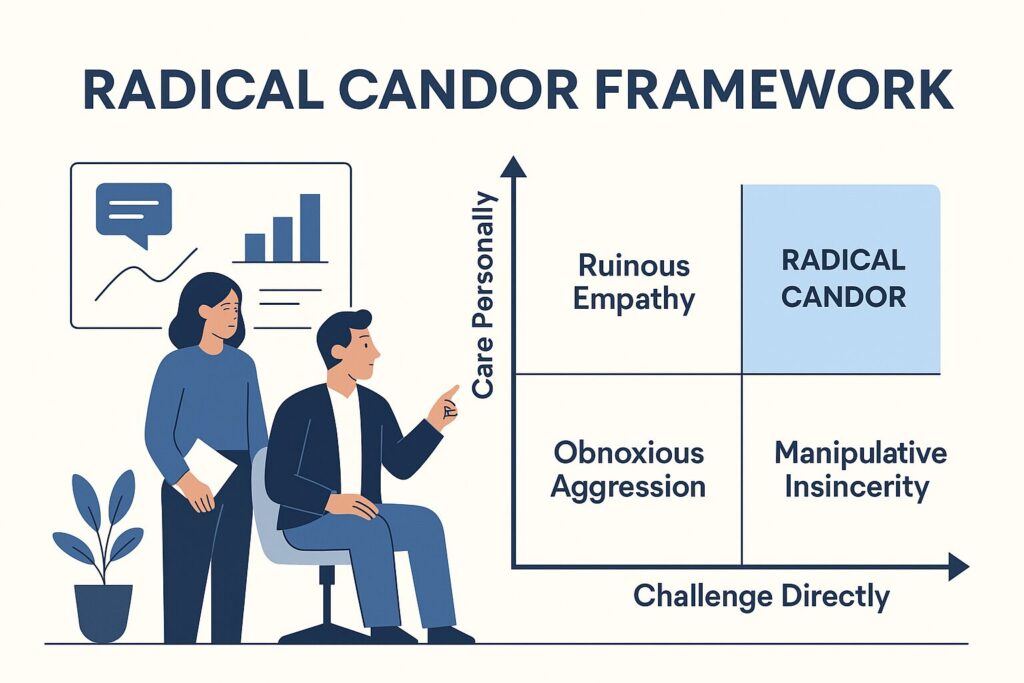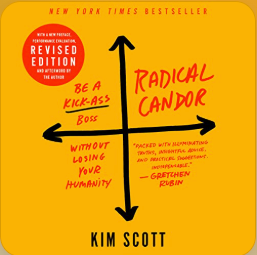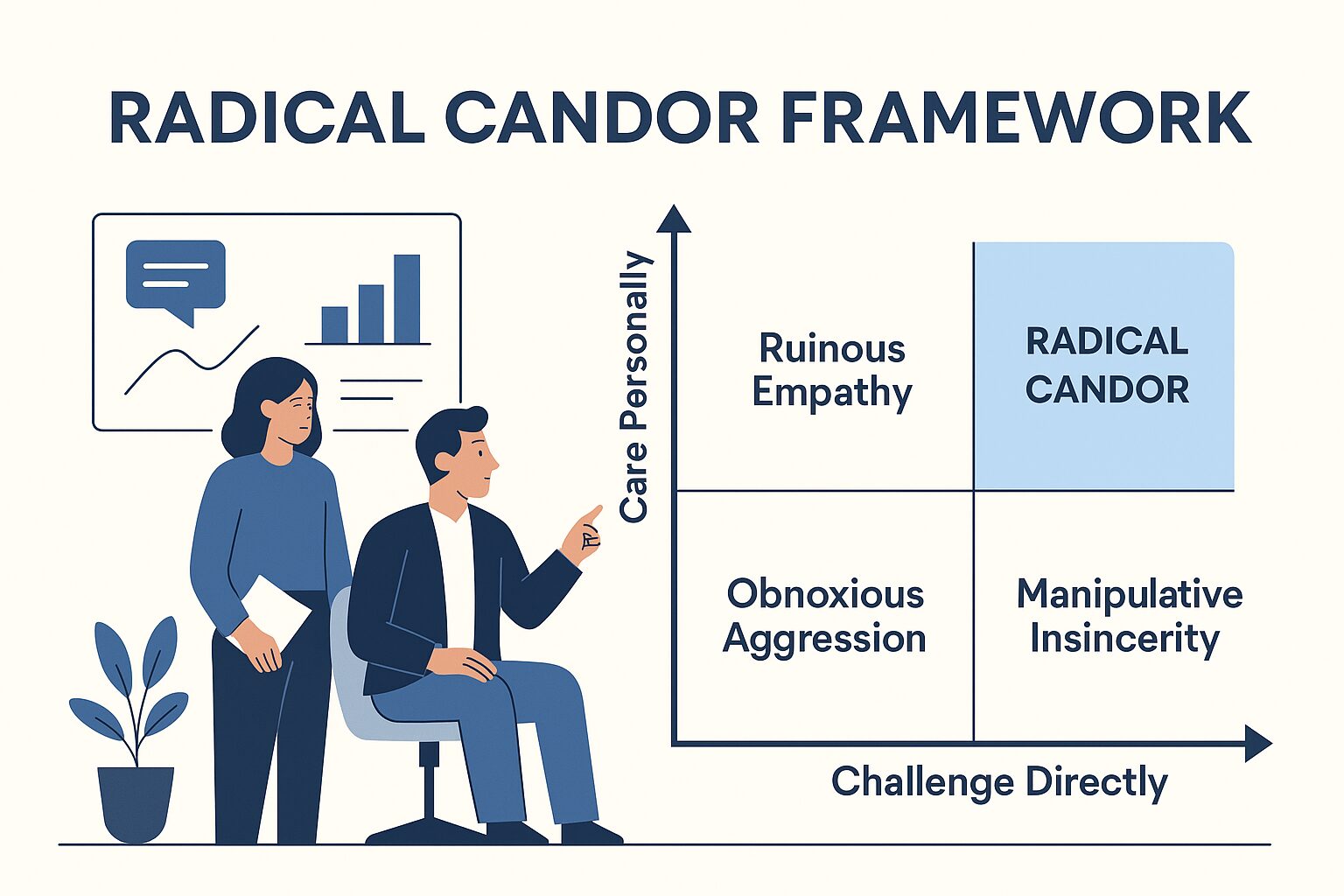Here’s a truth that’ll make you squirm: You’re not alone in this. Many managers, even the most well-intentioned, often inadvertently harm their teams because they’re missing a simple leadership tool – the radical candor framework.
I don’t mean you’re incompetent or lazy. You likely work your tail off, care deeply about your team, and genuinely want everyone to succeed. But here’s the kicker – you’re probably destroying morale and stunting growth because you’ve fallen into the most common leadership trap: being “nice” instead of helpful.
Sound familiar? You avoid giving that difficult feedback because you don’t want to hurt someone’s feelings. You let mediocre performance slide because confrontation feels awkward. You sugarcoat criticism until it’s so diluted that it becomes meaningless. Welcome to the world of “ruinous empathy,” and it’s killing your team’s potential.
Radical candor is the key to breaking free from the ‘nice manager’ trap. Embrace it, and watch as it revolutionizes your leadership style.

The Brutal Truth About “Nice” Management
Tell me about Sarah (not real name), a brilliant marketing director I worked with a few years back. She was everyone’s favorite boss – always supportive, never critical, constantly telling her team they were doing “great work.” The problem? Her team was underperforming, missing deadlines, and producing mediocre campaigns.
Unknowingly, Sarah was not being kind but rather cruel. Her ‘nice’ management style led to underperformance, missed deadlines, and mediocre campaigns.
Here’s what most new managers get dead wrong: They confuse kindness with avoiding difficult conversations. They think caring about people means protecting them from hard truths. But here’s the thing – when you don’t give people honest feedback, you’re not protecting them. You’re robbing them of the chance to grow, improve, and succeed.
This is the core insight behind radical candor leadership – sometimes, the most caring thing you can do is tell someone exactly what they need to hear, even when it’s uncomfortable.
Get ready to unlock your new leadership superpower- the radical candor framework.
Kim Scott’s radical candor framework is brilliantly simple and practical. It’s not a complex theory but a straightforward approach anyone can implement. The framework sits on two axes:
Care Personally + Challenge Directly = Radical Candor
Let’s break this down:
Care Personally: The Foundation of Trust
This isn’t about being best friends with your team (though that’s fine if it happens naturally). Caring personally means you genuinely give a damn about each person as a human being, not just as a productivity unit.
It means knowing that Jake’s stressed because his kid is struggling in school. It means remembering that Maria is passionate about sustainability and finding ways to incorporate that into her projects. It means showing up as a real person, not just a title.
Challenge Directly: The Growth Engine
This is where most managers chicken out. Challenging directly means saying what needs to be said, clearly and specifically, without dancing around the issue or burying it in compliment sandwiches.
It’s not about being harsh or mean – it’s about being honest and direct because you care enough to help someone improve.
The Four Quadrants That’ll Change Your Leadership Game
When you map these two dimensions, you get four distinct management styles:
1. Radical Candor (Care + Challenge): The sweet spot where the magic happens
2. Ruinous Empathy (Care but Don’t Challenge): The “nice” trap that helps nobody
3. Obnoxious Aggression (Challenge but Don’t Care): The jerk boss everyone hates
4. Manipulative Insincerity (Neither Care nor Challenge): Political passive-aggression
Most managers ping-pong between ruinous empathy and obnoxious aggression, never quite hitting that radical candor sweet spot.
Real-World Radical Candor in Action
Let me paint you a picture of how this plays out in practice.
Remember Sarah from earlier? After learning about radical candor, she completely transformed her approach. Instead of telling the struggling designer his work was “fine,” she sat down with him for a real conversation.
“Hey Tom, I care about your growth here, so I must be direct. Your last three designs missed the mark because they do not address our target audience’s pain points. Let me show you specifically what I mean, and let’s work together on a strategy to nail this next one.”
Notice what happened? She led with care (expressing investment in his growth), then challenged directly (specific feedback about what wasn’t working), and ended with support (offering to work together on solutions).
The result? Tom didn’t get defensive. He got energized. Finally, someone gave him the honest feedback he needed to improve. Within two months, his work quality skyrocketed, and he became one of Sarah’s strongest team members. This could be your team’s story, too.
The Quick Wins: Implementing Radical Candor This Week
Here’s how you can start practicing radical candor feedback immediately:
1. The Pre-Feedback Mindset Check
Before any difficult conversation, ask yourself: “Am I having this conversation because I care about this person’s success or because I’m frustrated?” If it’s the latter, wait until you can come from a place of genuine care.
2. The Specific Feedback Formula
Replace vague feedback like “good job” or “needs improvement” with the SBI model:
- Situation: When and where
- Behavior: What specifically happened
- Impact: The effect it had
3. The Follow-Up Rule
Radical candor isn’t a one-and-done conversation. Schedule a follow-up within a week to check progress and offer continued support.
4. Model Vulnerability
Ask your team for feedback on your leadership. When you’re open to criticism, you create psychological safety for others to receive it, too.
5. The Praise Precision Method
Just like with criticism, make your praise specific and tied to behaviors, not just outcomes. “Great job closing that deal” becomes “The way you listened to the client’s concerns and addressed each one specifically is what sealed that deal.”
The Data Behind the Framework
Research consistently backs up the radical candor approach. A study from Leadership IQ found that only 29 percent of employees always know if their performance is meeting expectations — 21 percent said they “never” understand how well they’re performing (CNBC, 2019).
Meanwhile, companies that give continuous strength-based feedback can reduce their turnover by almost 15%, and organizations with effective feedback systems see 14.9% lower turnover rates, according to Gallup research (Oak Engage, 2022).
Additionally, Gallup revealed that teams who received consistent feedback showed a 12.5% boost in productivity, while organizations utilizing real-time performance conversations reported a 29% increase in employee engagement (Psico Smart, 2024).
When Radical Candor Goes Wrong (And How to Fix It)
Let’s be real – you’re going to mess this up at first. Everyone does. Here are the most common pitfalls and how to avoid them:
The Timing Trap: Giving feedback when emotions are running high rarely works. Wait until you can approach the conversation calmly and constructively.
The Audience Issue: Radical candor is a private conversation, not a public performance. Challenging someone directly in front of their peers often backfires.
The Follow-Through Failure: Giving feedback without providing support or resources to improve is just criticism without purpose.
The Personality Mismatch: Some people need more care before hearing the Challenge. Others prefer you to cut straight to the point. Learn to read your people.
Your Radical Candor Action Plan
Here’s how to implement this framework systematically:
Week 1: Start with yourself. Ask three people you trust for honest feedback about your leadership style. Practice receiving criticism gracefully.
Week 2: Choose one team member who would benefit from more direct feedback. Have that conversation using the care + challenge framework.
Week 3: Implement regular one-on-ones with each team member. Use half the time for their agenda and your feedback and coaching.
Week 4: Create team norms around feedback. Make it clear that everyone, including you, is expected to give and receive honest input.
Month 2: Start tracking metrics. Are you seeing improvements in performance, engagement, and retention? Adjust your approach based on what’s working.
The Leadership Transformation You’ve Been Missing
Here’s my bold prediction: If you commit to practicing radical candor for 90 days, you’ll become a fundamentally different leader. Your team will trust you more, perform better, and thank you for the difficult conversations you used to avoid.
The managers who master this framework don’t just build better teams – they develop better humans. They create environments where people feel safe to take risks, are honest about their struggles, and are supported in their growth.
And here’s the beautiful irony: By learning to challenge people directly, you’ll become the kind of leader people want to follow.
Ready to transform your leadership style? The radical candor management approach isn’t just another management fad – it’s a fundamental shift in how you show up for your team.
What’s one difficult conversation you’ve been avoiding? Start there. Your team deserves a leader who cares enough to tell them the truth.
What to learn more: Get the book Radical Candor

Want more leadership frameworks that work? Subscribe to our weekly newsletter for actionable insights delivered straight to your inbox.
Related Articles
Build a Team That Runs Without You, Proven Systems
From Manager to Leader: How I Unlocked Real Growth
The Ultimate Guide to Leadership & Team Building for Modern Professionals
About the Author
I’m Richard Naimy – a strategic advisor to founders and operating leaders navigating growth, complexity, and innovation. I write for ambitious professionals who want to build smarter, scale faster, and lead with clarity.
I write about:

Leave a Reply